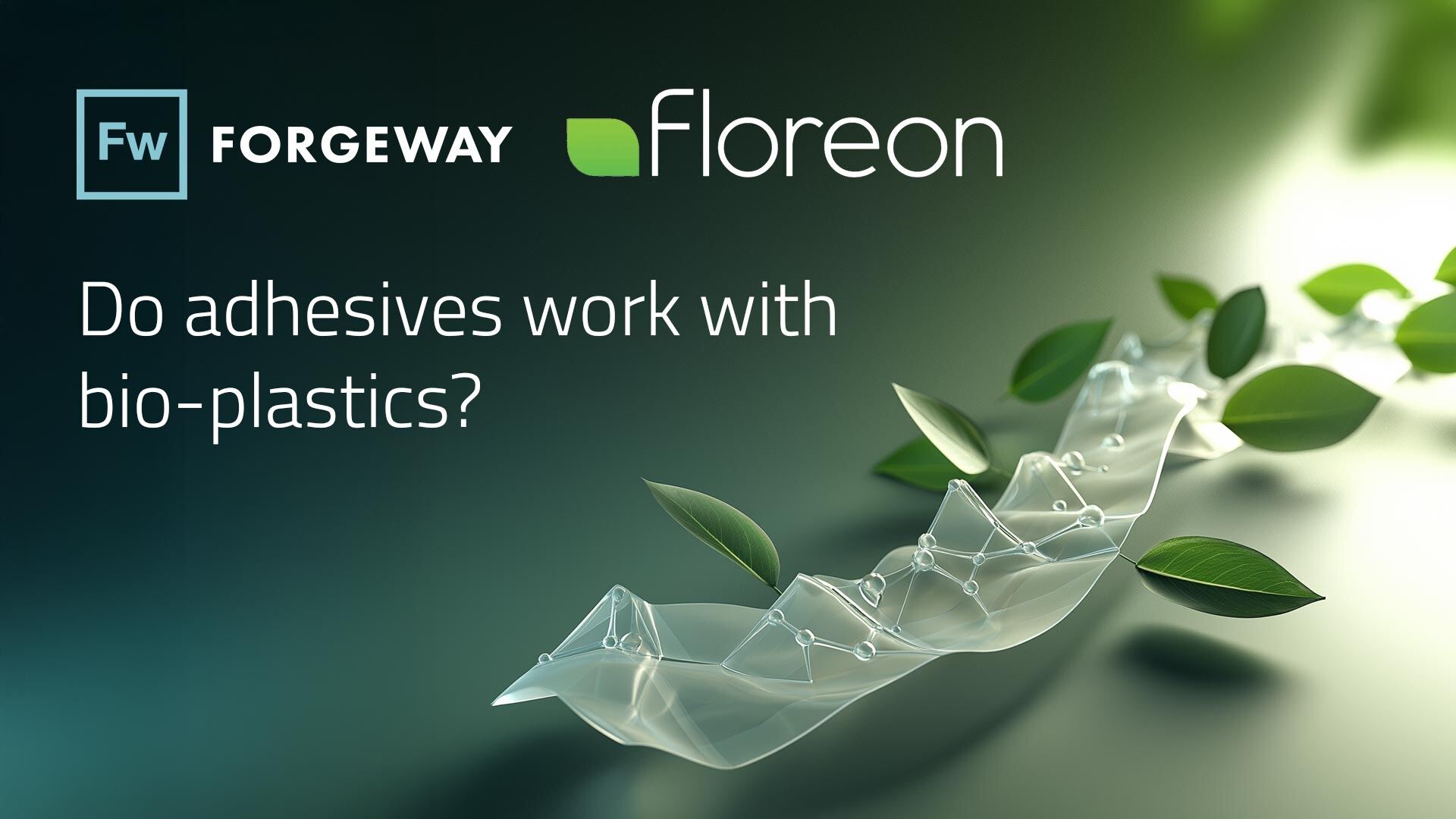
Why look at Adhesive performance with Bioplastics?
Bioplastics are becoming increasingly popular in manufacturing as industries search for more sustainable solutions. By replacing traditional petroleum-based plastics with materials derived from natural sources, companies are finding innovative ways to reduce their carbon footprint.
However, an important question arises: how do bioplastics perform when bonded using adhesives? Manufacturers may worry that the introduction of bio-based materials could negatively impact the adhesion process, potentially compromising the strength and reliability of bonds. To address this concern, we conducted a series of tests in partnership with one of the UK’s leading bioplastic manufacturers, Floreon.
Our goal was to evaluate how bioplastics compare to traditional industrial plastics, such as ABS and polystyrene, in their interaction with adhesives. The results provide valuable insights for manufacturers considering the switch to more sustainable materials.
The bondability of plastics...
The bondability of different plastics can vary significantly. Low Surface Energy (LSE) plastics, such as polyethylene and polypropylene, are notoriously difficult to bond due to their non-polar, chemically resistant surfaces. These materials often require specialised adhesives or surface treatments like flame treatment, plasma treatment, or primers to improve adhesion. In contrast, High Surface Energy (HSE) plastics, like ABS and polycarbonate, generally bond more effectively with a broader range of adhesives. The key to achieving a strong bond is selecting the right adhesive type and ensuring proper surface preparation to enhance adhesion performance.
How do Hybrid Polymer Adhesives perform with Bioplastics?
In our first set of tests, we evaluated the performance of our Formoa adhesives on three bio-based plastics from Floreon: Bio-Tech, Therma-Tech, and Dura-Tech. These materials were compared against standard industrial plastics such as ABS and polystyrene to assess adhesion quality.
Overview of Floreon Bioplastics
Bio-Tech: A PLA-based compound designed for applications requiring high rigidity and impact strength. Certified 'OK Compost,' it is fully biodegradable in industrial composting. Ideal for injection moulding in toys, cosmetics, and food packaging, offering a sustainable alternative to PS and other rigid polymers.
Therma-Tech: A PLA-based compound designed for durable, flame-retardant applications. A world-first, it includes a flame retardant, impact modifier, and nucleating agent, making it a drop-in FR ABS and FR PC replacement for injection moulding, extrusion, and 3D printing.
Dura-Tech: A PLA-based compound intended for high-impact applications while retaining a high renewable content, which can be certified to recognised criteria. It is recyclable both mechanically and chemically but not designed for compostable applications.
Methodology
To ensure consistent and reliable results, plastic substrates were carefully prepared. Release liners (where applicable) were removed, and surfaces were wiped with isopropyl alcohol to eliminate residues and create an optimal bonding surface. Formoa adhesive was applied either in an as-received (ASR) condition or with an adhesion promoter—Formoa Surface Activator (SA).
The adhesive was allowed to cure for at least 72 hours under standard lab conditions. A cut-and-peel test was then performed by scoring the adhesive bond with a sharp knife and pulling back the bead while making additional cuts. Adhesion performance was rated on a scale from 0 to 5:
0 = Poor adhesion; bead falls off during testing.
5 = 100% cohesive failure, indicating a strong bond.


Results
The cut-and-peel test results indicate that Formoa adhesives form strong bonds with bioplastics, particularly when paired with Formoa Surface Activator (SA). When bonded with Formoa 347 IQ, all Floreon bioplastics—Bio-Tech, Therma-Tech, and Dura-Tech—achieved a flawless score of 5 (100% cohesive failure) with SA, highlighting adhesion strength comparable to that of traditional plastics. With Formoa 063 and SA, scores ranged from 4 to 5, once again demonstrating strong adhesion similar to that seen with conventional plastics. Without the activator, adhesion performance dropped (scores between 2 and 4), though this was consistent with expectations based on results with ABS and polystyrene.
How Do Acrylic Adhesives Perform with Bioplastics?
In the second phase, we tested our Purok range of acrylic-based adhesives on the same five plastic materials, using an overlap shear test to evaluate performance under different conditions.
Methodology
Plastic substrates were prepared as before, with release liners removed and surfaces cleaned with isopropyl alcohol. Overlap shear specimens were bonded with dimensions of 12.5 x 25 x 0.5 mm (length x width x thickness). The specimens were allowed to cure for three days under standard conditions (20°C, 50% relative humidity) before testing on a universal tensometer. They were pulled apart at a rate of 50 mm/min, and the overlap shear strength (measured in MPa) and failure mode were recorded.


Results
The lap shear test revealed that Floreon Bio-Tech achieved the highest bond strength, reaching 9.38 MPa (VX85) and 8.93 MPa (VX60)—comparable to traditional plastics like ABS/G. In all cases involving bioplastics, the substrate failed before the adhesive, demonstrating excellent adhesion. The only case of adhesive failure was standard polystyrene with VX85.
Will Bioplastics Weaken Your Bonds?
Our tests demonstrate that bioplastics can bond effectively with adhesives, particularly when surface preparation is optimised. So the answer to the above question is no, bioplastics won't weaken your bonds. However it's important to note the use of Formoa Surface Activator significantly improved adhesion, reinforcing the importance of proper surface treatment.
These findings confirm that bioplastics can perform just as well as conventional plastics when used with adhesives. However, as always, individual testing is recommended before committing to a specific substrate or adhesive.
Acknowledgements
We extend our gratitude to Floreon for their collaboration and for supplying the bio-based materials used in these tests. Their innovative work in bioplastics is paving the way for a more sustainable future. For more information about their products and developments, visit their website.



